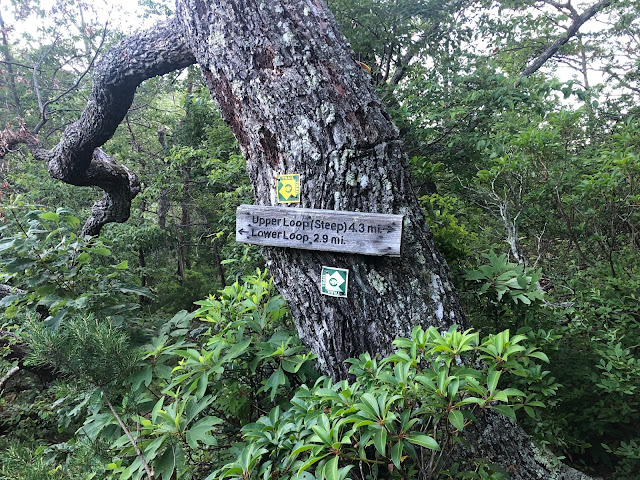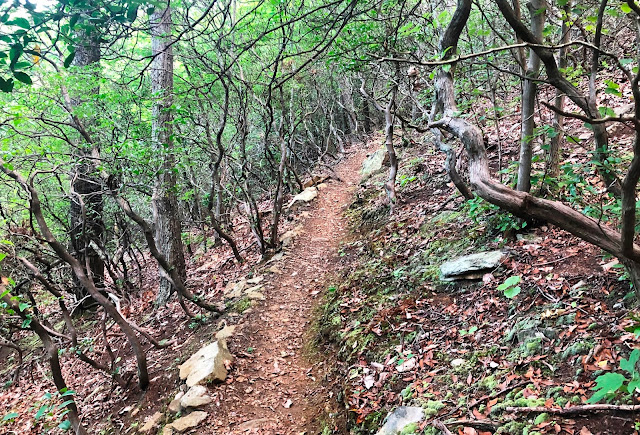69: Trail Less Traveled
L O V I N G S T O N, V A
The trail less-traveled is an addiction. And as usual, it’s the option taken a few miles back. This horseshoe-shaped mountain cove I’m hiking through offers two trails – an easier, shorter inner loop and a grinding outer loop, the challenge of which makes it the option less-traveled. The grinder leads to several open glades offering stunning views on this perfect morning where the air is still, the skies are deep blue, an overnight coolness still lingers, and the parking lot 800 feet below still has only my car in it. Very early starts to hikes secure such conditions, and a 3:30 a.m. alarm setting this morning has again borne wonderful fruits.
The mile climb up to the ridgeline of the outer loop and another mile along the rim has me sweaty and ready for a first break – time to take the weight off, re-hydrate, and deep-soak the essence of this west-facing glade. When I look up from setting my pack down though, I’m startled to find I’m being watched… by Ursus americanus, an American black bear. As adrenaline surges, the choice to take the trail less-traveled suddenly comes into question.
+ + +
When I arrived at Fortune’s Cove a few hours earlier I immediately noticed one of its best characteristics – an aural purity. This place is enveloped by an undisturbed natural symphony – the sweet trickling of Dillard’s Creek; its field grasses swaying gently in the breeze; and a cacophony of bird songs emanating from its trees. No flight path of planes overhead; no distant automobiles growling; and being alone on this 755-acre preserve kept all conversations silenced inside my head.
Beyond the purity of sound, what’s also unique here is its intersection. Virginia is comprised of five distinct geologic regions and at Fortune’s Cove the Piedmont meets the Blue Ridge. This boundary brings tremendous diversity. Piedmont-loving vineyards in the cove, for instance, are located just a few hundred yards up trail from Blue Ridge-loving mountain laurel. And mountain laurel thickets, in fact, make some of the best passages along the well-maintained trail. It wends through sections of the oddly twisted branches and seemingly tunnels just under the low canopy of these iconic mountain trees.
But the biggest attraction at Fortune’s Cove is the rocky glades along the outer loop trail. In simple terms, they’re viewing oases within an otherwise thickly forested geography. When I hike, I like to endeavor toward a reward, and what better reward than a highly elevated open glade offering rest and wonderful views?
In the late ‘90s, Jane Heyward, an avid hiker and amateur naturalist, first contacted The Nature Conservancy (TNC) in regard to donating her property – known now as Fortune’s Cove - so that others could enjoy its splendor in the way she had for so many years. Naturalists from Virginia’s Natural Heritage Program found a rare uniqueness among the many glades on the property. That uniqueness ultimately warranted TNC’s agreement to accept Heyward’s gift.
The glades at Fortune’s Cove are globally rare. The west-facing openings create very dry environments where an unusual combination of hearty plants thrives including lichens and rock mosses, little bluestem grasses, and an abundance of sweetly-fragrant fringetrees. Bobcat, white-tailed deer, red fox, raccoon, and black bear are also present. Year-round resident bird species include wild turkey, blue jay, cardinal, and red-tail hawk, as well as migratory songbirds such as the cerulean and blue-winged warbler, scarlet tanager, and orchard oriole.
TNC also works with the American Chestnut Foundation to manage an experimental grove located at the preserve. The once dominant American chestnut tree has become nearly extinct, but TNC’s work at Fortune’s Cove is an important pushback.
When I realize I’m being watched by a predatory wild animal, instinct and adrenaline brings one basic thought: back away. I’ll let the bear win this glade. It can have it. I grab my pack and begin a steady and deliberate retreat. Though not rushing, I turn frequently to gauge the bear’s interest in me. Bear have an incredibly powerful sense of smell, so if it wants to pursue my scent or the scent of trail mix in my pack, there’s no place to hide.
After a mile of steady backpedaling, the adrenaline begins to abate. I stop at a previously passed glade in hopes of recreating the rest, re-hydration, and deep-soak I was aiming for just prior to the bear encounter. I stand very still, look and listen for a long time and find no signs of being followed. Then stand still even longer, just to be sure. Finally, a sense of calm returns and the peace usually found at mountain overlooks sets in, as does a re-engagement with the aural purity.
A serenade of the common commences - mourning dove, pileated woodpeckers, blue jay, crow, and cardinal. Too often the common is overlooked, but right now, it’s a comforting companion. It’s also a wonderful accompaniment as I closely inspect the unique plants and insects attracted, just like me, to this glade.
After a time, the aural purity is broken – crunching gravel in the valley below reveals another car pulling into the parking lot. A lone figure steps out and onto the trail that leads to where I currently sit. A half hour from now, we’ll encounter each other and I’ll no longer have this cove to myself.
When she arrives, we exchange pleasantries but I don’t tell her about the bear. For one, she’s splitting off onto the lower loop away from where the bear was spotted, and for two, if our roles were reversed, I wouldn’t have wanted her to tell me. Knowing so would spoil the splendor of the unexpected found in places like Fortune’s Cove.
When my time at the glade ends and I make a final descent, I pass a group of chatty hikers just beginning their trudge up the steepest part of the trail. They already look tired. But like it has been for me, their efforts will surely be worth it. The rewards found here at Fortune’s Cove have been diverse, plentiful, unexpected, peaceful, twisted, and adrenalized.






Comments
Post a Comment
Please let me know what you think.